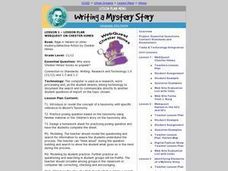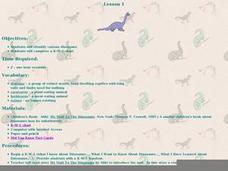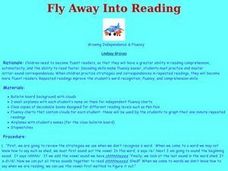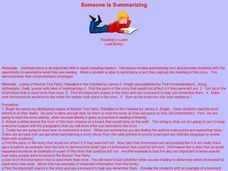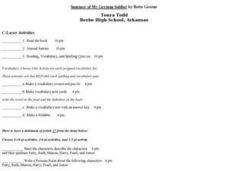Curated OER
The First Americans Today
Learners examine how Native American cultures are an important part of their existence. They look at celebrations, daily activities, values, and beliefs in a number of recommended books and share the information with other classmates.
Curated OER
Fraction Feast!
Students listen to various books about sharing food or food fractions. Then they discuss their fraction feast, examining the food and deciding how it can be shared to make fractions.
Curated OER
WebQuest on Chester Himes
Students perform a WebQuest to find out why Chester Hime's detective books were so popular. Small groups perform the research together then report to the class.
Curated OER
A Stinking Smelly Sewer
Learners create a timeline of events that occurred in the Nashua River Valley as presented in the book, "A River Ran Wild." They write a description of a selected time period on an index card for a class timeline, and write a letter to...
Curated OER
Identifying Dinosaurs
Students investigate basic information about dinosaurs. They listen to the book, "My Visit To the Dinosaurs," explore various websites, take an online quiz, and play an online dinosaur game.
Curated OER
Op Art Circles
Students create Optical Art, art that seems to move when you look at it, in this Art instructional activity for the High School classroom. Included with the instructional activity is a list of recommended materials and suggested resource...
Curated OER
Science: Leaf Study
First graders go on a leaf-hunting expedition around the schoolyard. They determine from which trees they fell using identification cards. Students read several books about leaves and apply their artistic skills by using the collected...
Curated OER
Movies in Your Mind
Students practice visualizing elements from a story. While reading a poem aloud, the instructor models what they see as they read the passage. Students draw a picture of a scene from the book "How to Eat Fried Worms" after reading it...
Curated OER
Shhh!!! I'm Reading!
Learners practice reading silently decodable texts in this lesson. They discuss the importance of being able to read silently. They then practice silently reading "Wemberly Worried." An assessment/checklist is included in this lesson.
Curated OER
Fly Away Into Reading
Young scholars complete repeated readings of the same passage in order to increase their reading fluency and comprehension. They listen as the teacher reads both with and without fluency to hear the difference. Working in small groups,...
Curated OER
It's Raining Meatballs
Students observe and demonstrate the process of summarization using the book "Cloudy With a Chance of Meatballs" by Judi Barrett. They silently read the story, and as a class discuss the five W's. Students then write a short summary of...
Curated OER
Successful Summarizers
Students review the concept of silent reading. Through modeling and guided practice, they explore six steps/rules of summarizing. In groups, they read a short book and then, using the summarization rules and skills, write an effective...
Curated OER
Speed Read
Students practice reading and rereading in order to increase their fluency with speed and accuracy. They review how to decode words and to reread selections so that they become more familiar with reading. Next, they read "James and the...
Curated OER
Shake Out the SH!
Learners study the /sh/ digraph using a tongue twister chart and practice saying the sound. They examine pictures to decide which contain the /sh/ sound and determine if the sound is at the beginning or end of the word. Next, working...
Curated OER
The Big E!
Students study the correspondence ea=/E/ by examining picture cards that show examples of items with the long "e" sound. They listen to a read aloud of Nancy Shaw's, Sheep Out to Eat before writing words that contain the "ea"...
Curated OER
Weather and Seasons
Students look through pictures to examine the seasons and seasonal activities which include the Salish months and traditional activities for each month. They also discover why certain activities are done at the same time each year and...
Curated OER
Let's Read with Expression
Pupils become good readers with expression by changing the volume, speed and pitch of their voices when they read with expression. They read with expression and emotion the book, "There was an Old Lady Who Swallowed a Fly," by Simms Taback.
Curated OER
Let's Be Emotion Detectors!
Students observe and demonstrate how to read with expression. They discuss the types of emotions and expressions to use while reading, and identify the appropriate punctuation for a variety of sentences. Students then write a sentence...
Curated OER
Someone is Summarizing
Students practice summarizing text using James E. Knight's, "Boston Tea Party, Rebellion in the Colonies." They read the story silently before summarizing it using main ideas and supporting details and deciding what type of information...
Curated OER
It Looked Like Spilt Milk
Class rereads book It Looked Like Spilt Milk and reviews what a good sentence looks like. They look at websites which contain cloud pictures and then use their imagination and draw on the computer their cloud pictures.
Curated OER
Bouncing and Dancing with B and D
Young scholars explore the differences between the letters b and d. They practice seeing the letters and hearing the sounds with words and tongue twisters. They practice letter formation for both letters and listen to the book, The...
Curated OER
Tom Sawyer
Students compare and analyze the relationship between Mark Twain's background and what they believe to be true about the book Tom Sawyer.
They apply correct sentence and paragraph construction in their writing.
Curated OER
Summer of My German Soldier
Students participate in a layered curriculum unit for a novel study. The teaching method allows for a student centered classroom that includes different methods of instruction and assessment.
Curated OER
The Miracle Worker
Eighth graders participate in a layered curriculum novel study on "The Miracle Worker". The students can choose from a variety of studies and assessments. This make the lesson more differentiated for multiple levels.


